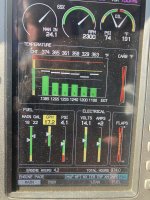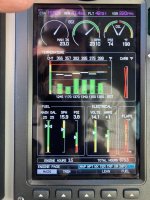Mconner7
Well Known Member
I have 8 hours on my newly overhauled O-540 carb engine. The oil consumption is practically non existent the last 4 hours.
I am sure the rings have seated but the CHT’s go to 410-415 on takeoff and drop as soon as I get the speed up and the power set for climb. At full rich (20+ gph) the CHT’s are all in low to mid 300’s.
Cylinders 4 and 6 are the hotter, if I try and lean below 15 gph at 65%, they are both close to 400. #4 heats very slowly but #6 will shoot from 350 to 400+ with just a 1 gph leaning.
Suggestions welcome.
I am sure the rings have seated but the CHT’s go to 410-415 on takeoff and drop as soon as I get the speed up and the power set for climb. At full rich (20+ gph) the CHT’s are all in low to mid 300’s.
Cylinders 4 and 6 are the hotter, if I try and lean below 15 gph at 65%, they are both close to 400. #4 heats very slowly but #6 will shoot from 350 to 400+ with just a 1 gph leaning.
Suggestions welcome.






